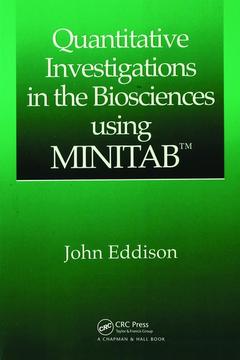Quantitative Investigations in the Biosciences using MINITAB
Auteur : Eddison John

Until recently, acquiring a background in the basic methodological principles that apply to most types of investigations meant struggling to obtain results through laborious calculations. The advent of statistical software packages has removed much of the tedium and many of the errors of manual calculations and allowed a marked increase in the depth and sophistication of analyses. Although most statistics classes now incorporate some instruction in using a statistics package, most introductory texts do not.
Quantitative Investigations in the Biosciences using MINITAB fills this void by providing an introduction to investigative methods that, in addition to outlining statistical principles and describing methods of calculations, also presents essential commands and interprets output from the statistics package MINITAB.
The author introduces the three basic elements of investigations-design, analysis, and reporting-using an extremely accessible approach that keeps mathematical detail to a minimum. He groups statistical tests according to the type of problem they are used to examine, such as comparisons, sequential relationships, and associations.
Quantitative Investigations in the Biosciences using MINITAB draws techniques and examples from a variety of subjects, ranging from physiology and biochemistry through to ecology, behavioral sciences, medicine, agriculture and horticulture, and complements the mathematical results with formal conclusions for all of the worked examples. It thus provides an ideal handbook for anyone in virtually any field who wants to apply statistical techniques to their investigations.
Date de parution : 08-2017
15.2x22.9 cm
Thèmes de Quantitative Investigations in the Biosciences using MINITAB :
Mots-clés :
Sea Water; John Eddison; Matched Pairs Signed Ranks Test; Cumulative Distribution Function; Minitab Dialog Box; Negative Standardized Residuals; Resting Pulse Rate; Minitab Output; Minitab Command; Data Set; Normal Probability Tables; Independent Groups; Standardized Residuals; Dialog Box; Menu Route; Wilcoxon Matched Pairs Signed Ranks Test; Wrinkled Peas; Sampling Units; Tukey Tests; Inter-quartile Range; Mann Whitney Test; Simple Random Sampling; Kruskal Wallis Test; Randomized Block Design; Sampling Wheat Plants; Minimum Sample Size



